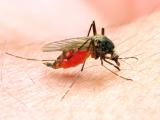Aug 1, 2012
CDC reports an active season for West Nile virus cases
The US Centers for Disease Control and Prevention (CDC) has received 241 reports of West Nile virus illness with 4 deaths so far this summer, the most through July since 2004. Some areas are reporting earlier and greater activity than usual, with 42 states citing cases in people, birds, or mosquitoes, the CDC said in a press release today. Almost 80% of the cases have been reported by three states, Texas, Mississippi, and Oklahoma, the agency said. The disease is transmitted by mosquitoes, and most cases occur from June through September, typically peaking in August. "It is not clear why we are seeing more activity than in recent years," Marc Fischer, MD, MPH, medical epidemiologist with the CDC’s Arboviral Diseases Branch, said in the release. "Regardless of the reasons for the increase, people should be aware of the West Nile virus activity in their area and take action to protect themselves and their family." About 1 in 5 people infected with the virus experience symptoms, such as fever, headache, and body aches, and less than 1% suffer a serious neurologic illness such as encephalitis or meningitis, the agency noted.
Aug 1 CDC news release
CDC West Nile information
Four more dead in Uganda's Ebola outbreak
Medical authorities in Uganda are reporting four more suspected Ebola deaths, raising the toll to 18, AllAfrica News reported today. The patients who died were all from Kibaale, a district in the western part of the country where the outbreak is centered. Fatalities included two children, ages 5 and 12 years old. Fourteen more patients with suspected infections were admitted to hospitals, 11 at Kagadi hospital and 3 at Mulago hospital in Kampala. A health ministry statement today said surveillance teams are closely monitoring 40 people. So far previously issued official statements and media reports have suggested that all of the patients are from Kibaale district, but today's AllAfrica report said authorities are investigating a suspected Ebola case in Mbarara district, located in southwestern Uganda. A report on the outbreak from CNN today quoted World Health Organization spokesman Tariq Jasarevic as saying that about three dozen suspected cases have been reported. The outbreak, which involves the Sudan strain, is the first known appearance of Ebola in Uganda since 2011, when the disease killed a 12-year-old girl. In 2007 an outbreak in the country involving a new strain killed 37 people.
Aug 1 AllAfrica news story
Aug 1 CNN story
Study: Malaria parasites grow more virulent after vaccination in mice
Malaria parasites might evolve into more virulent strains after malaria vaccination, according to the results of a mouse study published in PLoS Biology yesterday, but the authors caution against assuming the same would hold true for humans. A malaria vaccine has yet to be approved for human use, but several candidates are in trials. Penn State researchers vaccinated mice with the antigen AMA-1, which is used in several vaccine candidates. They then infected the mice with Plasmodium chabaudi, a malaria parasite that causes disease in mice but not people. After allowing the parasites to incubate for a week, they drew blood from the mice and inoculated other vaccinated mice with it, on the theory that only parasites resistant to AMA-1 would survive, enabling the pathogen to evolve. They conducted 20 such passages and found the surviving P chaboudi more virulent than the original ones. In fact, virulence increased even after only 10 serial passages. Also, virulence did not change in unvaccinated control mice. Of significance, the evolved parasites showed no change in the gene targeted by AMA-1, so the researchers concluded that evolution must have taken place elsewhere in the parasite's genome. The researchers caution against simply translating the results to people. "We are a long way from being able to assess the likelihood of this occurring in human malaria populations, were a malaria vaccine to go into widespread use," they wrote. They also argue for full-genome testing during malaria vaccine trials, recommending "that whole genome analyses of parasites that survive and are transmitted from individuals in vaccinated and control arms in clinical trials should be a priority."
Jul 31 PLoS Biol study
Jul 31 Penn State news release on the study
Australians finds pertussis vaccine protection gap
Researchers from Australia reported today that a sustained pertussis epidemic might be related to a shift from the whole-cell to the acellular diphtheria, tetanus, and pertussis (DTaP) vaccine, similar to what US health officials have recently found. The investigators from Queensland reported their findings in the Journal of the American Medical Association (JAMA). They wrote that the acellular version of the vaccine first became available in the state in 1996 and by March 1999 had replaced the whole-cell version as the publicly funded vaccine delivered to babies at 2, 4, and 6 months of age. Children born in 1998 received whole-cell vaccine, acellular vaccine, or both. Pertussis surveillance for 2011 showed that the highest incidence rates were in children age 6 to 11, which the researchers suspected was related to the vaccine shift. To test the hypothesis, they compared reporting rates in the preepidemic and outbreak periods, linking the data to the Queensland vaccine register. They found that children who received three doses of acellular vaccine had higher rates of pertussis than those who received three doses of whole-cell vaccine. Of those who got mixed doses, illness rates were highest for kids whose first dose was the acellular vaccine. The group concluded that the most important factor in the cohort was the initial vaccine the babies received, though other explanations could include antigenic shifts in circulating Bordetella pertussis strains.
Aug 1 JAMA research letter
Jul 19 CIDRAP News story "CDC: Pertussis numbers suggest vaccine protection gap"
USDA, EPA launch tool for assessing risk of food-, waterborne pathogens
The US Department of Agriculture (USDA) and Environmental Protection Agency (EPA) unveiled a new Microbial Risk Assessment (MRA) tool to help scientists improve the quality of data collected on food- and waterborne pathogens. "This new tool will help public health scientists target pathogen-related risks and prevent them from harming the public," USDA Under Secretary for Food Safety Elisabeth Hagen, MD, said in a news release from the USDA's Food Safety and Inspection Service (FSIS). Calling the tool the country's first "overarching microbial risk assessment guideline," the agencies say it lays out a comprehensive approach for conducting assessments of the risks to consumers, thereby differentiating it from formal pathogen risk assessments that federal officials have conducted for decades. "MRA procedures discussed in the document follow a user-friendly, question-and-answer format that assists risk assessors in developing microbial risk assessments to meet agency-specific needs," according to the FSIS release. EPA Science Advisor Glenn Paulson, PhD, said the MRA will improve the quality and consistency of risk assessments and provide greater transparency for stakeholders.
Jul 31 FSIS news release
FSIS MRA Guideline


















